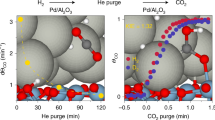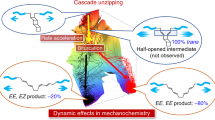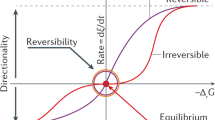Abstract
The reduction of disulfides has a broad importance in chemistry, biochemistry and materials science, particularly those methods that use mechanochemical activation. Here we show, using isotensional simulations, that strikingly different mechanisms govern disulfide cleavage depending on the external force. Desolvation and resolvation processes are found to be crucial, as they have a direct impact on activation free energies. The preferred pathway at moderate forces, a bimolecular SN2 attack of OH– at sulfur, competes with unimolecular C–S bond rupture at about 2 nN, and the latter even becomes barrierless at greater applied forces. Moreover, our study unveils a surprisingly rich reactivity scenario that also includes the transformation of concerted SN2 reactions into pure bond-breaking processes at specific forces. Given that these forces are easily reached in experiments, these insights will fundamentally change our understanding of mechanochemical activation in general, which is now expected to be considerably more intricate than previously thought.
This is a preview of subscription content, access via your institution
Access options
Subscribe to this journal
Receive 12 print issues and online access
$259.00 per year
only $21.58 per issue
Buy this article
- Purchase on Springer Link
- Instant access to full article PDF
Prices may be subject to local taxes which are calculated during checkout
 , for all five depicted reaction pathways.
, for all five depicted reaction pathways.



Similar content being viewed by others
References
Beyer, M. K. & Clausen-Schaumann, H. Mechanochemistry: the mechanical activation of covalent bonds. Chem. Rev. 105, 2921–2948 (2005).
Caruso, M. M. et al. Mechanically-induced chemical changes in polymeric materials. Chem. Rev. 109, 5755–5798 (2009).
Black, A. L., Lenhardt, J. M. & Craig, S. L. From molecular mechanochemistry to stress-responsive materials. J. Mater. Chem. 21, 1655–1663 (2011).
Huang, Z. & Boulatov, R. Chemomechanics: chemical kinetics for multiscale phenomena. Chem. Soc. Rev. 40, 2359–2384 (2011).
Ribas-Arino, J. & Marx, D. Covalent mechanochemistry: theoretical concepts and computational tools with applications to molecular nanomechanics. Chem. Rev. 112, 5412–5487 (2012).
Wiita, A. P., Ainavarapu, S. R. K., Huang, H. H. & Fernandez, J. M. Force-dependent chemical kinetics of disulfide bond reduction observed with single-molecule techniques. Proc. Natl Acad. Sci. USA 103, 7222–7227 (2006).
Wiita, A. P. et al. Probing the chemistry of thioredoxin catalysis with force. Nature 450, 124–127 (2007).
Ainavarapu, S. R. K., Wiita, A. P., Dougan, L., Uggerud, E. & Fernandez, J. M. Single-molecule force spectroscopy measurements of bond elongation during a bimolecular reaction. J. Am. Chem. Soc. 130, 6479–6487 (2008).
Liang, J. & Fernandez, J. M. Mechanochemistry: one bond at a time. ACS Nano 3, 1628–1645 (2009).
Garcia-Manyes, S., Liang, J., Szoszkiewicz, R., Kuo, T. L. & Fernandez, J. M. Force-activated reactivity switch in a bimolecular chemical reaction. Nat. Chem. 1, 236–242 (2009).
Alegre-Cebollada, J., Kosuri, P., Rivas-Pardo, J. A. & Fernandez, J. M. Direct observation of disulfide isomerization in a single protein. Nat. Chem. 3, 882–887 (2011).
Garcia-Manyes, S., Kuo, T.-L. & Fernandez, J. M. Contrasting the individual reactive pathways in protein unfolding and disulfide bond reduction observed within a single protein. J. Am. Chem. Soc. 133, 3104–3113 (2011).
Liang, J. & Fernández, J. M. Kinetic measurements on single-molecule disulfide bond cleavage. J. Am. Chem. Soc. 133, 3528–3534 (2011).
Popa, I., Kosuri, P., Alegre-Cebollada, J., Garcia-Manyes, S. & Fernandez, J. M. Force dependency of biochemical reactions measured by single-molecule force-clamp spectroscopy. Nat. Protocols 8, 1261–1276 (2013).
Szoszkiewicz, R . Single-molecule studies of disulfide bond reduction pathways used by human thioredoxin. Biophys. Chem. 173–174, 31–38 (2013).
Kucharski, T. J. et al. Kinetics of thiol/disulfide exchange correlate weakly with the restoring force in the disulfide moiety. Angew. Chem. Int. Ed. 48, 7040–7043 (2009).
Tian, Y., Kucharski, T. J., Yang, Q. Z. & Boulatov, R . Model studies of force-dependent kinetics of multi-barrier reactions. Nat. Commun. 4, 2538 (2013).
Hofbauer, F. & Frank, I. Disulfide bond cleavage: a redox reaction without electron transfer. Chem. Eur. J. 16, 5097–5101 (2010).
Li, W. & Gräter, F. Atomistic evidence of how force dynamically regulates thiol/disulfide exchange. J. Am. Chem. Soc. 132, 16790–16795 (2010).
Iozzi, M. F., Helgaker, T. & Uggerud, E. Influence of external force on properties and reactivity of disulfide bonds. J. Phys. Chem. A 115, 2308–2315 (2011).
Baldus, I. B. & Gräter, F. Mechanical force can fine-tune redox potentials of disulfide bonds. Biophys. J. 102, 622–629 (2012).
Keten, S., Chou, C.-C., van Duin, A. C. T. & Buehler, M. J. Tunable nanomechanics of protein disulfide bonds in redox microenvironments. J. Mech. Behav. Biomed. Mater. 5, 32–40 (2012).
Hofbauer, F. & Frank, I. CPMD simulation of a bimolecular chemical reaction: nucleophilic attack of a disulfide bond under mechanical stress. Chem. Eur. J. 18, 16332–16338 (2012).
Dopieralski, P. et al. The Janus-faced role of external forces in mechanochemical disulfide bond cleavage. Nat. Chem. 5, 685–691 (2013).
Anjukandi, P., Dopieralski, P., Ribas-Arino, J . & Marx, D. The effect of tensile stress on the conformational free energy landscape of disulfide bonds. PLoS ONE 9, e108812 (2014).
Zhou, B., Baldus, I. B., Li, W., Edwards, S. A. & Gräter, F. Identification of allosteric disulfides from prestress analysis. Biophys. J. 107, 672–681 (2014).
Wouters, M. A., Fan, S. W. & Haworth, N. L. Disulfides as redox switches: from molecular mechanisms to functional significance. Antioxid. Redox Signal. 12, 53–91 (2010).
Matthias, L. J. et al. Disulfide exchange in domain 2 of CD4 is required for entry of HIV-1. Nat. Immunol. 3, 727–732 (2002).
Hogg, P. J. Disulfide bonds as switches for protein function. Trends Biochem. Sci. 28, 210–214 (2003).
Ahamed, J. et al. Disulfide isomerization switches tissue factor from coagulation to cell signaling. Proc. Natl Acad. Sci. USA 103, 13932–13937 (2006).
Schmidt, B., Ho, L. & Hogg, P. J. Allosteric disulfide bonds. Biochemistry 45, 7429–7433 (2006).
Guo, X., Xiang, D., Duan, G. & Mou, P. A review of mechanochemistry applications in waste management. Waste Manag. 30, 4–10 (2010).
Zhang, X., Lu, Z., Tian, D., Li, H. & Lu, C. Mechanochemical devulcanization of ground tire rubber and its application in acoustic absorbent polyurethane foamed composites. J. Appl. Polym. Sci. 127, 4006–4014 (2013).
Rust, H. Non-chemical, mechanical procedure for the devulcanization of scrap rubber and/or elastomers and apparatus therefor. US patent 8,957,119 (2015).
Mars, W. V. & Fatemi, A. Factors that affect the fatigue life of rubber: a literature survey. Rubber Chem. Technol. 77, 391–412 (2004).
Persson, B. N. J., Albohr, O., Heinrich, G. & Ueba, H. Crack propagation in rubber-like materials. J. Phys. Condens. Matter 17, R1071–R1142 (2005).
Barcan, G. A., Zhang, X. & Waymouth, R. Structurally dynamic hydrogels derived from 1,2-dithiolanes. J. Am. Chem. Soc. 137, 5650–5653 (2015).
An, S. Y., Arunbabu, D., Noh, S. M., Song, Y. K. & Oh, J. K. Recent strategies to develop self-healable crosslinked polymeric networks. Chem. Commun. 51, 13058–13070 (2015).
Marx, D. & Hutter, J. Ab Initio Molecular Dynamics: Basic Theory and Advanced Methods (Cambridge Univ. Press, 2009).
Krupička, M. & Marx, D. Disfavoring mechanochemical reactions by stress-induced steric hindrance. J. Chem. Theory Comput. 11, 841–846 (2015).
Parker, A. J. & Kharasch, N. The scission of the sulfur–sulfur bond. Chem. Rev. 59, 583–628 (1959).
Singh, R. & Whitesides, G. M. in Supplement S: The Chemistry of Sulphur-Containing Functional Groups (eds Patai, S. & Rappoport, Z.) 633–658 (Wiley, 1993).
Hayes, J. M. & Bachrach, S. M. Effect of micro and bulk solvation on the mechanism of nucleophilic substitution at sulfur in disulfides. J. Phys. Chem. A 107, 7952–7961 (2003).
Fernandes, P. A. & Ramos, M. J. Theoretical insights into the mechanism for thiol/disulfide exchange. Chem. Eur. J. 10, 257–266 (2004).
Bach, R. D., Dmitrenko, O. & Thorpe, C. Mechanism of thiolate–disulfide interchange reactions in biochemistry. J. Org. Chem. 73, 12–21 (2008).
Swan, J. M. Mechanism of alkaline degradation of cystine residues in protein. Nature 179, 965 (1957).
Cecil, R. & McPhee, J. R. The sulfur chemistry of proteins. Adv. Protein Chem. 14, 255–389 (1959).
Florence, T. M. Degradation of protein disulphide bonds in dilute alkali. Biochem. J. 189, 507–520 (1980).
Grabowski, J. J. & Zhang, L. Dimethyl disulfide: anion–molecule reactions in the gas phase at 300 K. J. Am. Chem. Soc. 111, 1193–1203 (1989).
Bachrach, S. M. & Pereverzev, A. Competing elimination and substitution reactions of simple acyclic disulfides. Org. Biomol. Chem. 3, 2095–2101 (2005).
Tarbell, D. S. & Harnish, D. Cleavage of the carbon–sulfur bond in divalent sulfur compounds. Chem. Rev. 49, 1–90 (1951).
Paranjothy, M., Siebert, M. R., Hase, W. L. & Bachrach, S. M. Mechanism of thiolate–disulfide exchange: addition−elimination or effectively SN2? Effect of a shallow intermediate in gas-phase direct dynamics simulations. J. Phys. Chem. A 116, 11492–11499 (2012).
Heverly-Coulson, G. S., Boyd, R. J., Mó, O. & Yáñez, M. Revealing unexpected mechanisms for nucleophilic attack on S–S and Se–Se bridges. Chem. Eur. J. 19, 3629–3638 (2013).
Ribas-Arino, J., Shiga, M. & Marx, D. Understanding covalent mechanochemistry. Angew. Chem. Int. Ed. 48, 4190–4193 (2009).
Dopieralski, P., Ribas-Arino, J. & Marx, D. Force-transformed free energy surfaces and trajectory shooting simulations reveal the mechano-stereochemistry of cyclopropane ring-opening reactions. Angew. Chem. Int. Ed. 50, 7105–7108 (2011).
Marx, D., Chandra, A. & Tuckerman, M. E. Aqueous basic solutions: hydroxide solvation, structural diffusion, and comparison to the hydrated proton. Chem. Rev. 110, 2174–2216 (2010).
Bachrach, S. M. Computational Organic Chemistry (Wiley, 2007).
Mohamed, A. A. & Jensen, F. Steric effects in SN2 reactions. The influence of microsolvation. J. Phys. Chem. A 105, 3259–3268 (2001).
Dopieralski, P., Ribas-Arino, J., Anjukandi, P., Krupicka, M. & Marx, D. Force–induced reversal of β-eliminations: stressed disulfide bonds in alkaline solution. Angew. Chem. Int. Ed. 55, 1304–1308 (2016).
Acknowledgements
We are grateful to Deutsche Forschungsgemeinsschaft (Reinhart Koselleck Grant ‘Understanding Mechanochemistry’ MA 1547/9 and Cluster of Excellence ‘RESOLV’ EXC 1069), Alexander von Humboldt Stiftung (Humboldt Fellowships to J.R.A), Spanish Government (Ramón y Cajal Fellowship to J.R.A.), National Science Center Poland under Grant No. 2014/13/B/ST4/05009 and Ministry of Science and Higher Education Poland under Grant No. 627/STYP/9/20l4 (Fellowships to P.D.) for partial financial support. The authors acknowledge the Gauss Centre for Supercomputing (GCS) for providing computing time for a GCS Large Scale Project on JUQUEEN at the Jülich Supercomputing Centre as well as additional computational support by BOVILAB@RUB, HPC–RESOLV, Rechnerverbund–NRW, Wrocław Supercomputer Center, Galera–ACTION Cluster and Academic Computer Center in Gdańsk (CI TASK).
Author information
Authors and Affiliations
Contributions
P.D., J.R.-A. and D.M. conceived and designed the research; P.D. performed the calculations; P.D., J.R.-A., P.A., M.K. and D.M. analysed the data; P.D., J.R.-A. and D.M. co-wrote the paper.
Corresponding authors
Ethics declarations
Competing interests
The authors declare no competing financial interests.
Supplementary information
Supplementary information
Supplementary information (PDF 4308 kb)
Rights and permissions
About this article
Cite this article
Dopieralski, P., Ribas–Arino, J., Anjukandi, P. et al. Unexpected mechanochemical complexity in the mechanistic scenarios of disulfide bond reduction in alkaline solution. Nature Chem 9, 164–170 (2017). https://doi.org/10.1038/nchem.2632
Received:
Accepted:
Published:
Issue Date:
DOI: https://doi.org/10.1038/nchem.2632
This article is cited by
-
The many flavours of mechanochemistry and its plausible conceptual underpinnings
Nature Reviews Chemistry (2021)
-
Mechanoradicals in tensed tendon collagen as a source of oxidative stress
Nature Communications (2020)
-
The role of polymer mechanochemistry in responsive materials and additive manufacturing
Nature Reviews Materials (2020)
-
Chemical recycling of waste tire in high-temperature organic fluid
Journal of Material Cycles and Waste Management (2020)
-
Forcing the reversibility of a mechanochemical reaction
Nature Communications (2018)



